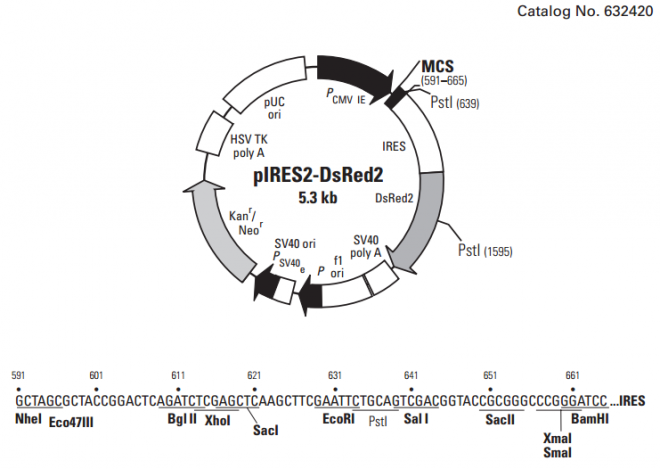pIRES2-DsRed2 载体
| 质粒类型: | 荧光蛋白报告载体 |
|---|---|
| 启动子: | CMV |
| 载体大小: | 5264 bp (查看载体序列) |
| 载体标签: | IRES-DsRed2 |
| 载体抗性: | Kanamycin (卡那霉素) |
| 筛选标记: | Neomycin (新霉素) |
pIRES2-DsRed2 contains the internal ribosome entry site (IRES; 1, 2) of the encephalomyocarditis virus (ECMV) between the MCS and the Discosoma sp. red fluorescent protein (DsRed2; 3, 4) coding region. This permits both the gene of interest (cloned into the MCS) and the DsRed2 gene to be translated from a single bicistronic mRNA. pIRES2-DsRed2 is designed for the efficient selection (by flow cytometry or other methods) of transiently transfected mammalian cells expressing DsRed2 and the protein of interest. Thisvector can express DsRed2 alone at lower signal intensity. The vector can also be used to obtain stably transfected cell lines by drug and clonal selection.
DsRed2 is a human codon-optimized (5) DsRed variant engineered for faster maturation and lower non-specific aggregation. The MCS in pIRES2-DsRed2 is located between the immediate early promoter of cytomegalovirus (PCMV IE) and the IRES sequence. SV40 polyadenylation signals downstream of the DsRed2 gene direct proper processing of the 3' end of the bicistronic mRNA. The vector backbone also contains an SV40 origin for replication in mammalian cells expressing the SV40 T antigen. A neomycin-resistance cassette (Neor), consisting of the SV40 early promoter, the neomycin/kanamycin resistance gene of Tn5, and polyadenylation signals from the herpes simplex virus thymidine kinase (HSV TK) gene, allows stably transfected eukaryotic cells to be selected using G418. A bacterial promoter upstream of this cassette expresses kanamycin resistance in E. coli. The pIRES2-DsRed2 backbone also provides a pUC origin of replication for propagation in E. coli and an f1 origin for single-stranded DNA production.
载体应用
pIRES2-DsRed2 can be used to quickly identify cells expressing a gene of interest by screening for DsRed2 fluorescence. Genes inserted into the MCS should include the initiating ATG codon. Selection of DsRed2-positive cells is possible 24 hr after transfection by flow cytometry or fluorescence microscopy. However, in some cases, up to 48 hr may be required for detection of red-emitting cells. pIRES2-DsRed2 and its derivatives can be introduced into mammalian cells using any standard transfection method. If required, stable transformants can be selected using G418 (6).


